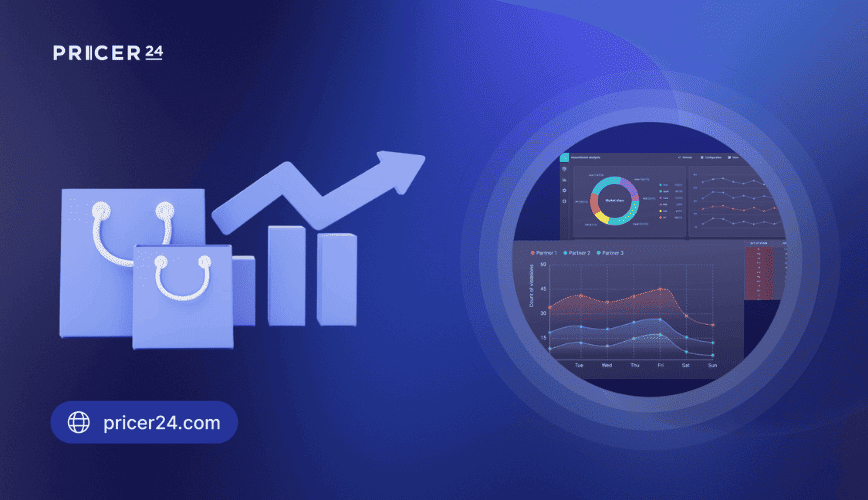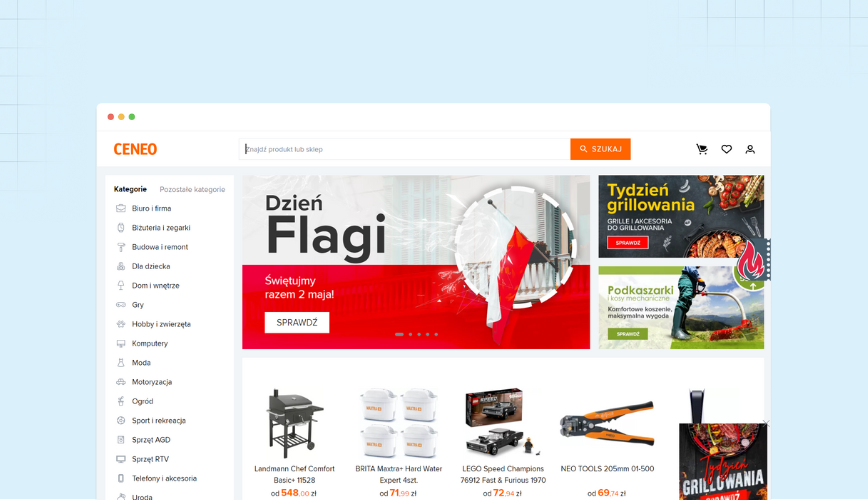Walmart, Aldi, Amazon, eBay, and other retail giants have mastered the art of leader pricing, using this strategy to dominate the market and win customer loyalty.
But what exactly is leader pricing, and how can it benefit — or challenge — a business? Let’s explore the concept, its advantages, and its potential pitfalls.
Contents:
What Is Leader Pricing?
Examples of Companies Implementing Leader Pricing
Examples of Leader Pricing in E-Commerce
Ways of Implementing Leader Pricing
Advantages of Leader Pricing
Disadvantages of Leader Pricing
What Is Leader Pricing?
The leader pricing strategy focuses on gaining a competitive edge by setting the lowest prices within an industry. It is often achieved through significant reductions in production, procurement, storage, logistics, promotion, and other operational costs. In essence, the business optimizes every aspect of its operations to offer the lowest prices on the market.
This strategy is typically adopted by large companies with substantial influence over the entire market. When one business controls pricing, others in the industry must adapt to align with the leader’s prices. Competitors continually adjust their offers, keeping a close eye on the price leader.
These are the key steps to achieving price dominance:
- Maximize production and operational efficiencies to reduce costs.
- Set the lowest prices within the segment.
- Increase market share by attracting more customers.
- Ensure profitability through high sales volume and economies of scale.
Examples of Companies Implementing Leader Pricing
Walmart
Walmart is a clear example of a company that has successfully implemented the leader pricing strategy. As a leading global retailer with an extensive network of stores across 24 countries, Walmart employs 2.3 million people and serves over 200 million customers weekly.
The company’s primary strategy is to maintain its position as the retailer with the lowest prices while offering a wide selection of products. Despite market fluctuations, Walmart’s gross margin has remained steady at 24–25% for the past two decades.
How did Walmart achieve this?
Initially, Walmart faced significant challenges in offering the lowest prices across key categories such as food, electronics, clothing, and home goods. Each category had intense competition from other major retailers with established market shares.
To maintain leader pricing, Walmart needed an efficient, highly coordinated logistics system. The company invested heavily in creating a massive, highly productive logistics network with automated warehouses, which significantly reduced transportation and storage costs.
Walmart also built long-term relationships with suppliers and manufacturers, focusing on economies of scale. By purchasing products in bulk, Walmart was able to secure lower prices than smaller retailers could obtain.
Rather than relying on frequent promotions or sales, Walmart keeps prices consistently low. Their Everyday Low Price (EDLP) strategy proved to be a groundbreaking business model. The idea behind this strategy is that customers prefer to buy at low, predictable prices rather than wait for discounts or sales events. The Everyday Low Price strategy has allowed Walmart to reduce product markups in favor of boosting overall profits through higher sales volumes.
Aldi
Another company that has successfully applied the leader pricing strategy is the German retailer Aldi, which targets middle-class consumers by offering quality products at low prices. Today, Aldi has more than 6,600 stores in 11 countries, including more than 2,200 stores in the United States, where the chain has already become the third largest grocery store chain after Walmart and Kroger.
How did Aldi achieve price leadership?
Aldi offers a small assortment of about 1,400–1,500 products, which is significantly less than what most competitors offer (the assortment of a traditional American supermarket usually includes about 30,000 items). Aldi buys products in bulk at the lowest prices, choosing a limited number of brands and at the same time ensuring good quality. This approach allows the company to achieve several goals at the same time:
- Reduce costs — a smaller assortment means lower storage and logistics costs
- Optimize purchases — purchasing in large volumes allows you to receive discounts from suppliers
In addition, Aldi takes a minimalist approach to store design. They usually have smaller premises compared to traditional supermarkets, and this is part of their cost-saving strategy.
Examples of Leader Pricing in E-Commerce
Amazon
Amazon is one of the best-known examples of leader pricing in online retail. The company actively employs a low-price strategy, offering an extensive range of products while frequently adjusting prices to attract buyers. In addition, Amazon uses dynamic pricing algorithms, enabling them to continuously adjust prices based on factors like demand, competitor pricing, and seasonal fluctuations.
Zalando
Zalando applies a leader pricing strategy in the online clothing trade, offering discounts on popular brands and regular promotions. In addition, the company uses personalized recommendations, which allows them to offer customers exactly the products they want to buy at a favorable price.
Best Buy
As a leader in electronics sales, Best Buy often uses the lowest price strategy to attract customers. The company offers low prices on popular products including smartphones, TVs, and computers, which allows them to remain competitive.
These examples of global retail giants vividly demonstrate various aspects of the leader pricing strategy. Let’s consider them in detail.
Ways of Implementing Leader Pricing
Economies of Scale
One of the most effective ways to achieve leader pricing is through economies of scale. The larger the production or purchase volume, the lower the per-unit cost of goods. Retailers can reduce their costs by negotiating bulk purchase contracts with suppliers. Large orders often come with discounts or more favorable terms, enabling businesses to offer more competitive prices.
For online stores that deal with high product volumes, this approach allows them to set more attractive prices for customers, giving them an edge over smaller competitors.
Real-Time Competitor Price Analysis
A key element of the leader pricing strategy is the ability to quickly adapt to market price changes. This requires continuous monitoring of competitor prices — and that’s where our price analysis platform comes in.
Automated Data Collection
The Pricer24 Price Crawler automatically scans competitors’ online stores, comparing their product pages with your SKUs. Price scraping tool ensures a continuous stream of up-to-date data without the need for manual collection, saving category managers valuable time and resources. And with an accuracy rate exceeding 99.5%, the data can be relied on to make informed decisions.
Real-Time Price Visualization and Analysis
The collected data is presented in customizable reports, including price monitoring, price comparison, competitor price tracking and price history analysis. This enables you to quickly respond to market trends and adjust your pricing — a crucial component of a leader pricing strategy.
Integration and Customization
Pricer24 integrates seamlessly with your systems via API, automating price adjustments on your site. This is particularly beneficial for companies implementing or planning to implement dynamic pricing strategies.
Beyond Prices
Pricer24 doesn’t just track prices; it also gathers other essential market data. This includes product availability, competitors’ assortment breadth, supplier stock levels, average product ratings, and customer reviews. Additionally, the system monitors deviations from the recommended retail price (RRP or MAP/MSRP), helping you track competitors’ adherence to manufacturer price standards.
Logistics Optimization
Effective logistics management and supply chain optimization (for example, reducing shipping costs) help to lower the final price of goods. Online stores can work with logistics partners on special terms.
Automating processes (such as order processing and warehouse management) also allows you to reduce operating costs. This can be accomplished through automated tools for processing applications, CRM systems for managing customer data, and other technical solutions.
Direct Agreements with Manufacturers
Establishing direct contracts with manufacturers to supply goods, bypassing intermediaries, is another effective way to reduce costs and set competitive prices. This approach is especially beneficial for online stores with significant sales volumes, as they can leverage their purchasing power to negotiate favorable terms.
By adopting this strategy, retailers can build a leader pricing model that offers low prices to attract customers while maintaining healthy margins.
Advantages of Leader Pricing
Clear advantages of the leader pricing strategy include:
- Rapid Expansion of the Customer Base and High Sales Volume
By offering low prices, a company can attract a large number of customers immediately upon entering the market, leading to a significant increase in sales volume.
- Increased Market Share
Becoming a price leader allows a company to quickly gain market share, creating high barriers for new competitors who may struggle to compete on price.
- Protection Against Economic Fluctuations
When consumers’ purchasing power decreases, a price leader’s affordable offerings remain attractive to budget-conscious customers, helping the business remain competitive during challenging economic times.
These advantages make leader pricing an appealing strategy, particularly in sectors like e-commerce where price competition is intense. However, as with any strategy, it’s crucial to consider the potential challenges associated with its implementation.
Disadvantages of Leader Pricing
- Risk of Dependency on High Sales Volumes
Companies employing this strategy rely on large sales volumes to benefit from cost reductions through economies of scale. However, if demand drops, it can significantly impact the stability of the company’s revenue.
- Difficulty Raising Prices
Price leaders, especially those positioned as discount retailers, may struggle when the market requires a price increase (for example, due to rising production costs). This can hinder their ability to respond quickly to market changes and adjust prices without losing customers.
- Competitive Pressure and Price Wars
The leader pricing strategy can provoke competitors to engage in even more aggressive price cutting, often resulting in price wars that can erode profitability across the entire sector, harming all businesses involved.
- Inability to Innovate
The need to maintain low costs can limit a company’s ability to invest in new technologies or modern equipment. This may slow innovation, diminish long-term competitiveness, and negatively impact the quality of products or services offered to customers.
Conclusion
The leader pricing strategy can be a powerful tool for driving rapid growth in market share and attracting new customers. However, to implement it successfully in highly competitive markets, it’s crucial not only to set competitive prices but also to consistently monitor market shifts. Real-time monitoring of competitors’ prices allows a retailer to swiftly adjust their strategy, stay responsive to market changes, and maintain a competitive edge.
FAQ
What is the leader pricing strategy?
Leader pricing is an approach where a company sets the lowest prices in the market to become the price leader. This helps the company attract more customers, as consumers often prefer more affordable options.
How does leader pricing affect a company’s profitability?
While the leader pricing strategy can help increase market share, it can also affect profitability. Lowering prices often leads to smaller profit margins, so companies need efficient cost management strategies to sustain profitability.
Can leader pricing be combined with other marketing strategies?
Yes, this strategy can be combined with other approaches, such as differentiation or targeting specific market segments. For example, a company could lower prices on its mass-market products while offering premium products at higher prices to cater to a wider range of demographics.









